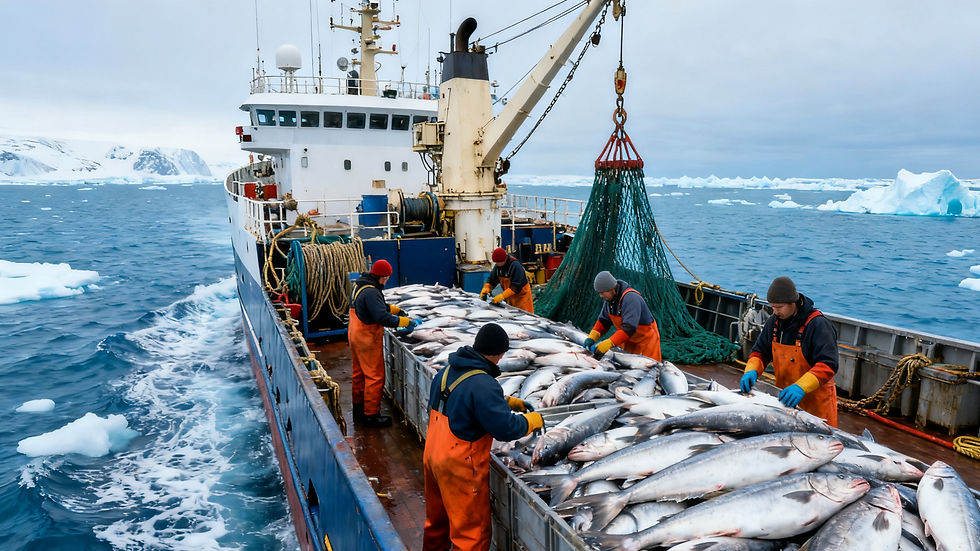Pollock Market Trapped in High-Level Deadlock, Chinese Processing Enterprises Caught in Dual Dilemma of "High Costs + Order Pressure"
- Easy Seafood

- Sep 21
- 3 min read
In mid-September 2025 (the 38th week, September 15-21), the global pollock market remained trapped in a deadlock of high-level operation, and the price decline expected by processing enterprises failed to materialize as scheduled. For Russia, the core supplier, quotations for 25cm+ headless and gutted (H&G) pollock raw materials remained stable in the range of 1,550-1,600 USD/ton. Even though some sellers made slight concessions due to the rising resistance from Chinese buyers, they failed to shake the overall firmness of prices. Compared with the same period in 2024, current raw material prices are about 44% higher, and this increase has directly pushed the raw material costs of Chinese processing enterprises to a record high, with profit margins being squeezed first.
1. Export Profits Squeezed by Both Tariffs and Buyer Resistance
Affected by the adjustment of EU policies in 2024, Russian pollock products not only lost the preferential treatment of zero-tariff quotas but also had to bear an additional 13.7% tariff. This change has dealt a fatal blow to the export profits of Chinese pollock processing enterprises. Currently, the FOB (Free On Board) price of secondary frozen whole fillets at Chinese ports is mostly 2,900-3,000 USD/ton, and the CIF (Cost, Insurance and Freight) price to Europe after adding tariffs has risen to 3,200-3,250 USD/ton, which is almost the same as the contract price of US B-season PBO fillets. Facing cost transmission, European buyers have adopted a firm attitude, clearly resisting further price increases, leaving Chinese enterprises unable to pass on the pressure of raw material price hikes to the downstream, and export profits have fallen into a dilemma of "passive compression".
2. Risks from Early Orders: Losses Loom, Enterprises Shift to "Small-Order Strategy" for Risk Aversion
Before the sharp rise in raw material prices in 2025, some Chinese enterprises signed low-cost export contracts, which now face the awkward situation of "production leading to losses". Based on the current calculation of raw material, processing and transportation costs, the prices of these orders can no longer cover the basic costs. To avoid risks, most factories in the industry have had to adjust their order-taking strategies and shift to a small-batch order model of 20-30 containers. Through the "small-order strategy", they reduce the losses that may be caused by large-scale supply. This cautious operation reflects the industry's growing concern about the uncertainty of the future pollock market.
3. US Large-Scale Procurement Boosts Demand, Making Raw Material Price Cuts Harder
On September 18, the United States Department of Agriculture (USDA) announced its latest procurement plan, stating that it intends to purchase a total of 15,000 metric tons of pollock PBO fillets in the 2025 B-season and the 2026 A and B seasons, with a procurement amount of up to 1 billion US dollars. This news has quickly boosted market expectations. The industry generally believes that the large-scale procurement by the US government will further exacerbate the demand gap for pollock raw materials, which will not only support the current high prices but may even trigger a new round of price increases. For Chinese enterprises that have been looking forward to lower raw material prices, this undoubtedly means a further reduction in the possibility of cost declines in the future.
4. European Consumer Side Under Pressure, Order Risks Emerge
The affordability of the European consumer side is continuously declining. Taking Germany, a major European market, as an example, the retail price of pollock fish sticks at local supermarket chains Aldi Nord and Aldi Süd is currently 2.49 Euros per pack. The industry generally regards 3 Euros per pack as the "psychological threshold" for consumers—if raw material costs continue to push retail prices above this threshold, market demand is likely to shrink significantly. Historical data also confirms this concern: when the price of pollock fish sticks rose to 3.49 Euros per pack, sales in the European market dropped significantly. Chinese processing enterprises are highly vigilant about this. Once the consumer side cools down, the European orders they have undertaken may face the risk of reduction or even cancellation, further increasing operational pressure.
5. Overall Challenge: Seeking Balance Under Triple Pressures
From the perspective of the current market pattern, the firmness of Russian raw material prices, the large-scale procurement by the US government, and the price sensitivity of the European consumer side together constitute the core contradiction of the pollock industry, and also trap the market in a two-way stalemate of "tight supply and demand + high prices". For Chinese pollock processing enterprises, how to balance production and export under the triple pressures of "high costs, low profits, and unstable orders" will become the biggest challenge they must face in the next period. The breakthrough of the market deadlock may have to wait for new balance signals from both the supply and demand sides.




Comments